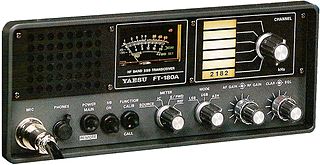
An electronic oscillator is an electronic circuit that produces a periodic, oscillating electronic signal, often a sine wave or a square wave. Oscillators convert direct current (DC) from a power supply to an alternating current (AC) signal. They are widely used in many electronic devices ranging from simplest clock generators to digital instruments and complex computers and peripherals etc. Common examples of signals generated by oscillators include signals broadcast by radio and television transmitters, clock signals that regulate computers and quartz clocks, and the sounds produced by electronic beepers and video games.

A superheterodyne receiver, often shortened to superhet, is a type of radio receiver that uses frequency mixing to convert a received signal to a fixed intermediate frequency (IF) which can be more conveniently processed than the original carrier frequency. It was invented by US engineer Edwin Armstrong in 1918 during World War I. Virtually all modern radio receivers use the superheterodyne principle.

The theremin is an electronic musical instrument controlled without physical contact by the thereminist (performer). It is named after its inventor, Léon Theremin, who patented the device in 1928.

Wilkinsburg is a borough in Allegheny County, Pennsylvania, United States adjacent to five neighborhoods of the city of Pittsburgh and borders four other boroughs and one township. The population of Wilkinsburg was 15,930, according to the 2010 census, having declined by 13,923 official residents in the 70 years since the 1940 census, when 29,853 people were enumerated. The borough of Wilkinsburg was named for John Wilkins, Jr., a United States Army officer who served as Quartermaster General of the United States Army from 1796 to 1802.

A crystal radio receiver, also called a crystal set, is a simple radio receiver, popular in the early days of radio. It uses only the power of the received radio signal to produce sound, needing no external power. It is named for its most important component, a crystal detector, originally made from a piece of crystalline mineral such as galena. This component is now called a diode.

A regenerative circuit is an amplifier circuit that employs positive feedback. Some of the output of the amplifying device is applied back to its input so as to add to the input signal, increasing the amplification. One example is the Schmitt trigger, but the most common use of the term is in RF amplifiers, and especially regenerative receivers, to greatly increase the gain of a single amplifier stage.
A variable frequency oscillator (VFO) in electronics is an oscillator whose frequency can be tuned over some range. It is a necessary component in any tunable radio receiver or transmitter that works by the superheterodyne principle, and controls the frequency to which the apparatus is tuned.

Yaesu is a Japanese brand of commercial and amateur radio equipment.

Rockwell Collins was a multinational corporation company headquartered in Cedar Rapids, Iowa providing avionics and information technology systems and services to government agencies and aircraft manufacturers. The company was acquired by United Technologies Corporation on November 27, 2018, and now operates as part of Collins Aerospace.
The Beverage antenna or "wave antenna" is a long-wire receiving antenna mainly used in the low frequency and medium frequency radio bands, invented by Harold H. Beverage in 1921. It is used by amateur radio, shortwave listening, and longwave radio DXers and military applications.

A spark-gap transmitter is an obsolete type of radio transmitter which generates radio waves by means of an electric spark. Spark-gap transmitters were the first type of radio transmitter, and were the main type used during the wireless telegraphy or "spark" era, the first three decades of radio, from 1887 to the end of World War 1. German physicist Heinrich Hertz built the first experimental spark-gap transmitters in 1887, with which he proved the existence of radio waves and studied their properties.

Frank Conrad was an electrical engineer, best known for radio development, including his work as a pioneer broadcaster. He worked for the Westinghouse Electrical and Manufacturing Company in East Pittsburgh, Pennsylvania for half a century. His experimental radio station provided the inspiration, and he acted in an advisory role, for the establishment of Westinghouse's first broadcasting service, over radio station KDKA.

WBVP and WMBA are news/talk radio stations based in Beaver Falls, Pennsylvania, United States. The stations serve Beaver County, Pennsylvania and simulcast their programming. The stations are owned by Mark and Cynthia Peterson, through licensee Sound Ideas Media, LLC.
Radio receiver design includes the electronic design of different components of a radio receiver which processes the radio frequency signal from an antenna in order to produce usable information such as audio. The complexity of a modern receiver and the possible range of circuitry and methods employed are more generally covered in electronics and communications engineering. The term radio receiver is understood in this article to mean any device which is intended to receive a radio signal in order to generate useful information from the signal, most notably a recreation of the so-called baseband signal which modulated the radio signal at the time of transmission in a communications or broadcast system.

Joseph Harold Negri is an American jazz guitarist and educator. He appeared on the 1959 children's television program Adventure Time.
Harold Henry "Bev" Beverage is perhaps most widely known today for his invention and development of the wave antenna, which came to be known as the Beverage antenna and which for the last few decades has seen a resurgence in use within the amateur radio and broadcast DXing hobbyist communities. Less widely known is that Bev was a pioneer of radio engineering and his engineering research paralleled the development of radio transmission technology throughout his professional career with significant contributions not only in the field of radio frequency antennas but also radio frequency propagation and systems engineering.

Vintage amateur radio is a subset of amateur radio hobby where enthusiasts collect, restore, preserve, build, and operate amateur radio equipment from bygone years, such as those using vacuum tube technology. Popular modes of operation include speaking over amplitude modulation (AM), and communicating using Morse code through continuous wave (CW) radiotelegraphy. Some enthusiasts have interest in owning, restoring and operating vintage military and commercial radio equipment such as those from 1940s to 1960s. Some undertake to construct their own gear, known in ham slang as homebrewing, using vintage parts and designs. A number of amateur radio clubs and organizations sponsor contests, events, and swap meets that cater to this specialized aspect of the hobby.

The AN/URM-25 signal generator was an electronic vacuum-tube radio-frequency (RF) signal generator used during the 1950s and 1960s by the U.S. Military to test electronic equipment.
Watkins-Johnson Company was a designer and manufacturer of electronic devices, systems, and equipment. The company, commonly referred to as "W-J", was formed in 1957 by Dean A. Watkins and H. Richard Johnson, and was headquartered in Palo Alto, California. Its products included microwave tubes, followed by solid-state microwave devices, electronic warfare subsystems and systems, receiving equipment, antennas, furnaces and semiconductor manufacturing equipment, and automated test equipment.
The Regional Industrial Development Corporation of Southwestern Pennsylvania--known colloquially as the RIDC--is a privately funded non-profit serving the Pittsburgh metropolitan area to focus on a regional approach to economic development primarily through managing and rehabilitating area research and business parks for modern tenants. The RIDC was formed on August 8, 1955 as a non-profit corporation after area business, corporate, government and labor leaders supported a central agency responsible for developing and coordinating efforts to create new employment and economic diversity. As of March 2013 it is listed as the third largest commercial property manager in metropolitan Pittsburgh with 7,400,000 gross leasable square feet, behind only Oxford Development and CBRE Group while surpassing Jones Lang LaSalle.














